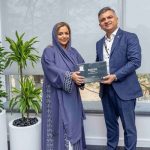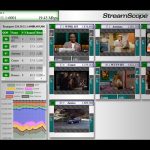The worlds elite squash players descended on Burj Park, Downtown Dubai for the PSA Dubai World Series Finals last month. We go behind the scenes to find out what it takes to broadcast a truly world-class sporting event from the heart of the city. When Saudi businessman Ziad Al-Turki took over the reins of the UK-headquartered […]
 The worlds elite squash players descended on Burj Park, Downtown Dubai for the PSA Dubai World Series Finals last month. We go behind the scenes to find out what it takes to broadcast a truly world-class sporting event from the heart of the city.
The worlds elite squash players descended on Burj Park, Downtown Dubai for the PSA Dubai World Series Finals last month. We go behind the scenes to find out what it takes to broadcast a truly world-class sporting event from the heart of the city.
When Saudi businessman Ziad Al-Turki took over the reins of the UK-headquartered Professional Squash Association (PSA), he was told that squash would never be televised, that the fledgling sport lacked the makings of a professional sport to break onto the world stage and would remain limited to specific territories. Today, the situation is quite different. Thanks to PSA-owned Squash TV, the sport is not only televised but also streamed live on different platforms in many parts of the world and has won a significant fan following over the last few years.
Broadcasting the sport has been instrumental in growing its reach and popularity.
I think weve proven everyone wrong. The matches reach audiences around the world through our online streaming platform Squash TV and we hope to have TV coverage throughout the world in the near future, says Ziad Al-Turki, Chairman of PSA.
Ziad Al-Turki, a squash enthusiast, first joined the PSA board in 2009. He says his interest in the game is purely altruistic and he got involved to help raise the bar for the welfare of the players.
Squash had to compete with world-class sports if it wanted to get any kind of funding from sponsors, and in order to do tha,t I had to change the way the sport was presented. It required a total revamp of the courts, the lighting, the seating arena and even the technical infrastructure to televise it on broadcast-grade equipment.
Al-Turki used the PSA World Series Finals as a showcase for what could be achieved with the right presentation. In January 2011, unveiling the purple Z-Court in an inflatable on Centre Court at The Queens Club in London put squash in the limelight, and it began to receive recognition as a world-class sport. Consequently, Sky Sports televised the World Series Finals in 2012 and 2013, with Eurosport joining in 2013.
It was a milestone achievement for PSA and me when broadcasters such as Sky Sports and Eurosport came on board, Al-Turki comments.
There was no looking back, and the sport continued to make strides in the international arena. Following an agreement between Dubai Sports Council and PSA, facilitated by Falcon and Associates, a strategic advisory company working on behalf of the Dubai leadership, the PSA World Tour was brought to Dubai this year.
For Dubai to consider hosting the World Series Finals was a stamp of approval that all of the efforts over the past few years had come to fruition. Dubai is definitely the catalyst that will take squash to the next level, says Al-Turki.
The 2016 PSA Dubai World Series Finals saw the worlds eight best male and female players compete in a five-day squash extravaganza.
Within the purpose-built venue set against the backdrop of the worlds tallest building, the iconic Burj Khalifa, a state-of-the-art glass squash court took pride of place complete with world-class broadcast infrastructure to showcase the matches around the world.
Peter Schmidl, International Affairs and Event Coordination at ASB SquashCourts, the German company behind the court in Dubai, says his team built the glass court from scratch keeping in mind the requirements of the game, the players and the spectators, as well as the TV crew. To date, ASB has supplied more than 6,000 ASB squash courts to customers in 70 countries.
The glass court has a stunning visual appearance and is acclaimed by the TV industry for creating a dramatic setting that adapts perfectly to the demands of such a high-speed televised sport. Everything required for the court was brought in from Germany and assembled here with the help of our engineers, says Schmidl.
The court this year had a new front wall with a complete LED screen behind it, used to show videos during breaks. This kind of distribution of content has never been done before on a squash court, according to Schmidl.

Al-Turki elaborates on the special addition of the LED screen, calling it prime advertising space to target both live and TV audiences.
We have to constantly innovate to stay at the forefront and engage both spectators and sponsors. The new LED wall offers sponsors the ability to engage spectators by getting their message across either through video or branding and gives us endless possibilities to engage with spectators.
The video wall was built with frosted glass that has the same characteristics as the glass used for the court walls, with LED screens behind it.
This was a first step and by no means perfect, but presenting it for the first time in Dubai, a city known for being at the forefront of innovation, was the logical thing to do. We now know what changes we need to make to perfect it and have already started working on those changes. Weve also been approached by manufacturers that have cutting-edge displays and want to help us perfect this innovation while also showcasing their technologies, says Al-Turki.
Filming the game
In order to capture the live action from the court, eight cameras fixed position, remote operated and roaming were installed in various positions in the tent. 21 flight cases of heavy-duty broadcast equipment were flown in from London to Dubai, including cameras, encoders and hundreds of metres of cabling for a live TV production.
An 11-person TV crew was also flown in, including a director, replay operator, graphic operator, sound engineer, equipment engineer, ENG cameraman, remote camera operator, slow-mo camera operator, slow-mo cameraman, features and news editor, and a colour footage cameraman.
Six Panasonic remote control cameras (known as hot heads) were deployed alongside a Panasonic ENG / P2 camera and a super slow-mo camera. The cameras were positioned strategically to capture the action from all angles so viewers would not miss any of the action on court.
Nathan Clarke, PR and Communications Manager of PSA, gives the details of the choice of cameras and their positions: Two raised main cameras focusing on the front wall, an overhead camera and two cameras on the back wall facing the court, as well as two on the glass front wall also facing the court, ensured every second of the games was captured from various angles. An additional camera was installed for beauty shots.
Clarke says that hot heads are a great fit for events, where there are space constraints.
Hot heads fit into tight spaces and dont block any camera views of the court. They also allow one operator to man many cameras, giving production a bigger feel on a smaller budget.
The super slow-mo cameras added several levels to production. They came in handy to add a visual element to the commentators descriptions of techniques and to showcase the athleticism of the players. The ENG camera allowed more range of movement and was used for player close-ups, walk-ons and so on. This camera also doubled as an interview camera.
The audio was captured using five mics installed strategically in and around the court. The guest commentators for the matches used two commentary headsets with lip mics. Two court mics and two audience mics were clamped to the court fins. One tie mic was also subtly placed on the fin by the glass door of the court.
UK-based Squash TV streams close to 500 matches live and the crew also produces daily highlight edits for YouTube and shares live content on social media. The PSA matches are also streamed to Eurosport Player as well as to mainstream broadcast partners Tennis Channel, BT Sport, beIN Sport, Astro Sports, China Telecom, FOX Australia, NOW TV Hong Kong, Singtel, Sky Sports NZ, Super Sports, Ten Sports, Truevisions and Eurosport.

Clarke explains that for the first few days the footage was transported to the London hub using dedicated web uplink servers. For the Finals, however, an SNG truck was used to uplink the footage. For the Eurosport live feed, a direct stream from Dubai was re-encoded in London to reach 13-14 different platforms.
At the heart of the production was a NewTek 3Play multi-camera replay server used for four-channel redundant recording and fast turnaround time for post-production workflows. The idea was to capture every angle of live action for instant replay, playback or archive. The mixing desk, remote camera controls, sound desk and hyper deck for recordings and a series of engineering racks were housed in a broadcast area in the tent, with all cabling running under the stands or over them.
A single stream was specifically tunnelled from the tournament to the Squash TV hub in London, using a minimum 10GB upload speed with a safety margin to ensure reliability. From London, it served encoders for Squash TV and Eurosport Player. The stream was transcoded for viewers on a multitude of devices from mobiles to smart TVs. For the semis and finals, the feeds were sent directly to partner broadcasters.
The editors received a live feed via HDMI cable hardwired to their laptops for online editing. The footage in Apple Pro Res (422) 1080p format was stored on two WD drives.
We could play the highlights within five minutes of the match. Both FCP 7 and Premier Pro were used for editing, which was done on-site and heavily linked with the rest of the production.
We use a QNAP network drive to allow on-the-fly editing of matches, which is important for long days and short turnaround times. Usually, a full men and women 32-draw tournament is around three TB. We keep back-up on the QNAP in case of any disasters, notes Clarke.
UK broadcast graphics company MOOV worked on the project with long-time partner ChyronHego, for its first Virtual Placement project. Virtual graphics can be placed into a scene within minutes of set-up, ready for use in a multitude of applications using Virtual Placement without having to add any specialist camera encoders or lengthy calibration processes.
When the robotic camera looked up, the roof structure was replaced with a live shot of Burj Khalifa, accompanied with player images, logos and a five-metre-wide #squashindubai image from outside.
The road ahead
Al-Turki is optimistic about the future of squash and believes that broadcasting the sport has helped its growth.
While our TV rights arent very lucrative, they do provide the base for us to achieve lucrative contracts from world tour sponsors, and help local sponsors secure sponsorships for their individual tournaments. In addition to our existing three-year deals with broadcasters, we are looking to cover the remaining missing parts of the globe with future broadcast partnerships.
Dubai will host the World Series Finals for the next two years, with the venue moving to Dubai Opera.
The 2,000-seat Dubai Opera is an amazing modern facility with endless possibilities. Although we are still a year away from the tournament, we have already started thinking of next years presentation. We plan to have the LED screen in the new venue and hope to perfect it the next time around, concludes Al-Turki.
















































































